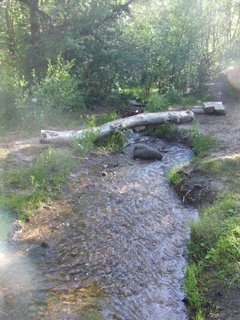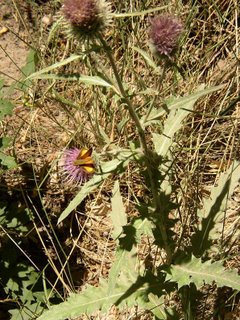City Creek, Revisited
Some pictures from Friday. Yay! This is almost certainly poison ivy! I know, if I wanted to be certain, all I'd have to do is touch it (assuming I'm not immune), but I'd really rather not. Incidentally, there's a bit of disagreement between my books on this one. All agree the leaves come in threes and are shiny with prominent veins. One says it's a shrub that can be up to six feet tall. One says it's 4-10 inches tall. And there's some disagreement as to whether Toxicodendron radicans, Rhus radicans, and/or Toxicodendron rydbergii are just different names for the same plant, or whether some of these are, in fact, poison oak instead. At a guess? Recent reclassification and not all the books have caught up. Probably ONE of these CAN grow to be a large shrub, but the one pictured is more likely the 4-10 inch variety.
Yay! This is almost certainly poison ivy! I know, if I wanted to be certain, all I'd have to do is touch it (assuming I'm not immune), but I'd really rather not. Incidentally, there's a bit of disagreement between my books on this one. All agree the leaves come in threes and are shiny with prominent veins. One says it's a shrub that can be up to six feet tall. One says it's 4-10 inches tall. And there's some disagreement as to whether Toxicodendron radicans, Rhus radicans, and/or Toxicodendron rydbergii are just different names for the same plant, or whether some of these are, in fact, poison oak instead. At a guess? Recent reclassification and not all the books have caught up. Probably ONE of these CAN grow to be a large shrub, but the one pictured is more likely the 4-10 inch variety. This is just a shot of the creek with some cool effects from the sun.
This is just a shot of the creek with some cool effects from the sun. And the common sunflower, now blooming on a roadside near you! ;^) Anyway, this is Helianthus annus. The seeds are edible, like the sunflower seeds we buy, but they must be tiny. I would expect it to be difficult to gather enough of them to make much of a meal.
And the common sunflower, now blooming on a roadside near you! ;^) Anyway, this is Helianthus annus. The seeds are edible, like the sunflower seeds we buy, but they must be tiny. I would expect it to be difficult to gather enough of them to make much of a meal. And this seems to be a bryophyte called Golden star-moss, aka Campylium stellatum. I've seen this quite often. What's a bryophyte? *shrugs* Some primitive type of plant life is all I know.
And this seems to be a bryophyte called Golden star-moss, aka Campylium stellatum. I've seen this quite often. What's a bryophyte? *shrugs* Some primitive type of plant life is all I know. I looked at these and thought "milkvetch" at first, but they grow to be rather large and hardy shrubs. In fact, it seems that it is Wild Licorice, Glycyrrhiza lepidota. They're not quite in focus, but like many members of the pea family, licorice seeds come in pods. These are a bit rougher and sticker than most. And it is edible and used as a flavoring agent. Might be fun to gather some, as I cannot eat commercial licorice candy. They use wheat flour as a binder.
I looked at these and thought "milkvetch" at first, but they grow to be rather large and hardy shrubs. In fact, it seems that it is Wild Licorice, Glycyrrhiza lepidota. They're not quite in focus, but like many members of the pea family, licorice seeds come in pods. These are a bit rougher and sticker than most. And it is edible and used as a flavoring agent. Might be fun to gather some, as I cannot eat commercial licorice candy. They use wheat flour as a binder. More hollyhock.
More hollyhock. Here's a common one. Salsify, aka Goat's Beard, aka Tragopogon dubius. I've got these in my lawn. Supposedly the flowers close up at noon [PRM], but I've seen them out later than that. *shrugs* When they go to seed, you can see that they look like giant dandelion puffs.
Here's a common one. Salsify, aka Goat's Beard, aka Tragopogon dubius. I've got these in my lawn. Supposedly the flowers close up at noon [PRM], but I've seen them out later than that. *shrugs* When they go to seed, you can see that they look like giant dandelion puffs. Not sure what the plant is, but Fibonacci and I decided that the little black dots were probably aphids. So this is an aphid farm run by ants. I saw several similar "farms" along City Creek.
Not sure what the plant is, but Fibonacci and I decided that the little black dots were probably aphids. So this is an aphid farm run by ants. I saw several similar "farms" along City Creek. A pretty butterfly (maybe moth) on a bull thistle. And...the Woodland Skipper, Ocholodes sylvanoides, is the closest match to the moth's shape and color. So it might be that, or a relative.
A pretty butterfly (maybe moth) on a bull thistle. And...the Woodland Skipper, Ocholodes sylvanoides, is the closest match to the moth's shape and color. So it might be that, or a relative. This one is definitely called Coneflower, aka Ratibida columnifera. Hmmm... from Wildflowers of the RM, the flower heads may be used to make dye and the roots have been known to cure toothaches.
This one is definitely called Coneflower, aka Ratibida columnifera. Hmmm... from Wildflowers of the RM, the flower heads may be used to make dye and the roots have been known to cure toothaches. These are delicious. Some sort of currant (also called gooseberry). I'm not sure which, since these were clearly ripe, but were more orange than red. All of the ones I'm finding are either black or red when ripe.
These are delicious. Some sort of currant (also called gooseberry). I'm not sure which, since these were clearly ripe, but were more orange than red. All of the ones I'm finding are either black or red when ripe.




4 comments:
You could be mis-informing us about the alleged poisen ivy and we'd never know. I'm ashamed. *looks reproachful*
:P
:^D Hey, my books are misinforming me! But the photo matches the pictures in the book. And... it just occurred to me to check my Weed book. It says that poison ivy [Rhus radicans, Toxicodendron rybergii or Toxicodendron radicans] gets up to 18 inches but it may grow as a vine and climb up to maybe 4 feet. And it specifies that Poison oak is Rhus toxicodendron, and that its leaves resemble oak leaves, but doesn't mention height.
But if you'd like, I'll gather some of the plant I found and send it to you for testing. ;^D
Hmmm... after these two web-sites:
Survive Outdoors
and
Poison Ivy
I declare myself convinced. Though I think some of their poison ivy is actually poison oak, based on the leaf structure.
No, no, I believe your research will be quite adequate. No need to waste all that money on postage, after all. :P
Post a Comment